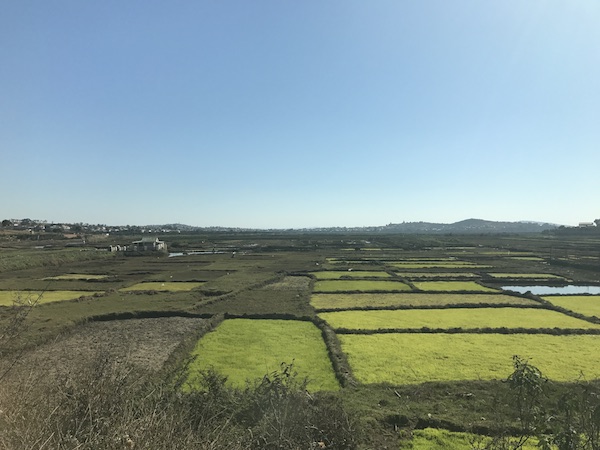After last night’s challenges, I’m pleased to say things have smoothed out here in Madagascar.
Today, Joe (my guide for this trip) and I drove west from the capital – Antananarivo – on Highway Number 1. If you’re picturing a highway in the traditional sense, downgrade your expectations. It’s more like an unmarked, rural road that vacillates between one and two lanes as it cuts through crowded villages. In many places, there are more people walking the road than driving it. Along the entire route, people pull carts filled with sticks (to burn for heat) or mud bricks (to stack for houses). In nicer villages, oxcarts slowed our progress. More than once, we had to slow down so as not to run over somebody’s scrawny chicken (there are lots of scrawny chickens everywhere in Madagascar). Many of the pedestrians we passed balanced huge baskets of produce on their heads.
Highway 1 leads west and we took it as far as Lake Kavitaha, where I am now. Kavitaha is?the second largest lake on this, the world?s fourth largest island. For a bit of context, Madagascar is twice the size of Great Britain and home to 24 million people. I will only see a tiny sliver of it in the five days I?ll spend here.
I’m fortunate to have Joe (who saved my hide last night) as pilot and guide. Driving this narrow, winding highway requires great skill. Avoiding the bicycles, carts, zebu, and pedestrians would be one thing. But throw in the massive and slow-moving trucks, and things get really complicated, really quickly. Zebu, by the way are humped cattle from South Asia that serve as a kind of symbol of wealth around here.
Joe and I were both tired from our late night so we stopped for lunch and a quick tour at a Lemur Preserve along the highway. The park is home to about 50 lemurs and a handful of endangered turtles. They all seemed happy to lounge for our eager cameras.
Most of the time, I’m right up in front, snapping pictures of whatever comes my way. This trip, however, I’m attempting to spend less time experiencing the world through my iPhone’s camera and more time enjoying the world directly.
For the guided tour of the nature preserve, I tagged along with a French family whose matriarch did not share my conservative approach to the camera. She must have taken dozens of pictures of every tree, scores of photos of each lemur, and I couldn’t even keep count of the snapshots she made of every turtle. She seemed to really like the turtles.
When she noticed I wasn’t taking very many photos, she decided to move through the language barrier to show me what seemed like every photo she’d taken from her previous stops. It was exhausting and really slowed our progress on the trail. I got the hint and began taking photos to end her slideshow. So much for “enjoying the world directly.”

Lemurs are as captivated by us as we are by them. The one on the bottom was staring at the French lady. And, yes. That’s a dirty look.
Admittedly, my initial impression of Madagascar was somewhat sullied by last night’s immigration challenges, but I’m glad to say that all of that turned around today. The countryside we drove through today is breathtaking. And the lemurs were really neat.
This is most definitely a poor country. According to Joe, some 70% of the population gets by on less than US$2 per day.
And here’s what fascinates me about our world. Think about it: Just two days ago, I was in Monaco, one of the richest places on earth. Today, I’m in Madagascar, one of the poorest. And, despite their vast differences, seeing these two places back to back has taught me that…






I’m traveling the world through your eyes and words. Keep them coming.
Thanks for following along!